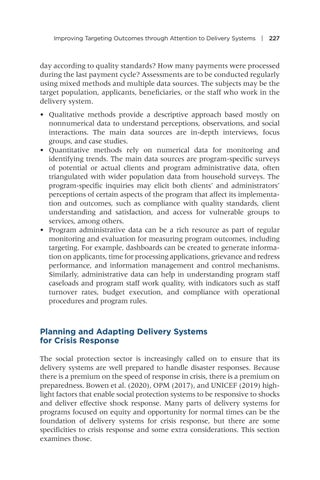Improving Targeting Outcomes through Attention to Delivery Systems | 227
day according to quality standards? How many payments were processed during the last payment cycle? Assessments are to be conducted regularly using mixed methods and multiple data sources. The subjects may be the target population, applicants, beneficiaries, or the staff who work in the delivery system. • Qualitative methods provide a descriptive approach based mostly on nonnumerical data to understand perceptions, observations, and social interactions. The main data sources are in-depth interviews, focus groups, and case studies. • Quantitative methods rely on numerical data for monitoring and identifying trends. The main data sources are program-specific surveys of potential or actual clients and program administrative data, often triangulated with wider population data from household surveys. The program-specific inquiries may elicit both clients’ and administrators’ perceptions of certain aspects of the program that affect its implementation and outcomes, such as compliance with quality standards, client understanding and satisfaction, and access for vulnerable groups to services, among others. • Program administrative data can be a rich resource as part of regular monitoring and evaluation for measuring program outcomes, including targeting. For example, dashboards can be created to generate information on applicants, time for processing applications, grievance and redress performance, and information management and control mechanisms. Similarly, administrative data can help in understanding program staff caseloads and program staff work quality, with indicators such as staff turnover rates, budget execution, and compliance with operational procedures and program rules.
Planning and Adapting Delivery Systems for Crisis Response The social protection sector is increasingly called on to ensure that its delivery systems are well prepared to handle disaster responses. Because there is a premium on the speed of response in crisis, there is a premium on preparedness. Bowen et al. (2020), OPM (2017), and UNICEF (2019) highlight factors that enable social protection systems to be responsive to shocks and deliver effective shock response. Many parts of delivery systems for programs focused on equity and opportunity for normal times can be the foundation of delivery systems for crisis response, but there are some specificities to crisis response and some extra considerations. This section examines those.


